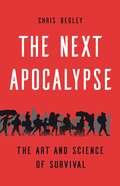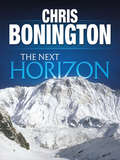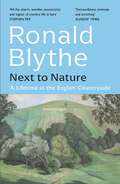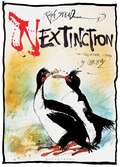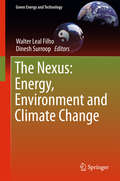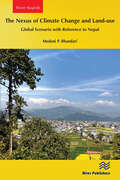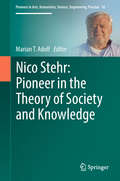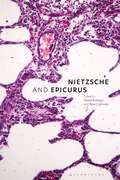- Table View
- List View
The Next Apocalypse: The Art and Science of Survival
by Chris BegleyIn this insightful book, an underwater archaeologist and survival coach shows how understanding the collapse of civilizations can help us prepare for a troubled future.Pandemic, climate change, or war: our era is ripe with the odor of doomsday. In movies, books, and more, our imaginations run wild with visions of dreadful, abandoned cities and returning to the land in a desperate attempt at survival.In The Next Apocalypse, archaeologist Chris Begley argues that we completely misunderstand how disaster works. Examining past collapses of civilizations, such as the Maya and Rome, he argues that these breakdowns are actually less about cataclysmic destruction than they are about long processes of change. In short: it&’s what happens after the initial uproar that matters. Some people abandon their homes and neighbors; others band together to start anew. As we anticipate our own fate, Begley tells us that it was communities, not lone heroes, who survived past apocalypses—and who will survive the next.Fusing archaeology, survivalism, and social criticism, The Next Apocalypse is an essential read for anxious times.
The Next Economics: Global Cases in Energy, Environment, and Climate Change
by Woodrow W. ClarkThe Next Economics focuses on how the field of economics must change and incorporate environment, energy, health and new technologies that are called externalities for stopping and reversing climate change. The field of economics needs to become a science. Economics in this book for the Green Industrial Revolution which goes beyond the third industrial revolution since it covers cases, examples and specific economic analyses that both scientific and global. The book concerns climate change and how the Economics for Externalities, needs to range from energy and national security to infrastructure and communities. Solutions and cases of the “Next Economics” are based in western philosophical economic paradigms and how that is changing due to the significance of current global economic and societal concerns. Finally practical applications for economics are explored using global environmental and energy issues. Areas that need a fresh look at and be integrated with economics, include the environment, social and political issues, energy, health climate change and their infrastructures, as they are major components of the macroeconomics for the future. Based on past economic models, these subjects have been lost or ill fitted into modern economic theory. The challenge is to explore and to look deeply into economics in order to provide it a new direction with the possibility for understanding, changing and saving the planet from climate change. This book presents to economists and policy-makers alike areas of environmental economics, energy policy, health and social issues which are needed to stop and reverse climate change.
Next Generation Compliance: Environmental Regulation for the Modern Era
by Cynthia GilesNearly everyone accepts as gospel two assumptions: compliance with environmental rules is high, and enforcement is responsible for making compliance happen. Both are wrong. In fact, serious violations of environmental regulations are widespread, and by far the most important driver of compliance results is not enforcement but the structure of the rule itself. In Next Generation Compliance, Cynthia Giles shows that well-designed regulations deploying creative strategies to make compliance the default can achieve excellent implementation outcomes. Poorly designed rules that create many opportunities to evade, obfuscate, or ignore will have dismal performance that no amount of enforcement will ever fix. Rampant violations have real consequences: unhealthy air, polluted water, contaminated drinking water, exposure to dangerous chemicals, and unrestrained climate-forcing pollution. They also land hardest on already overburdened communities - that's why Next Gen and environmental justice are tightly linked. The good news is there are tools to build much better compliance into regulations, including many tested strategies that can be the building blocks of programs that withstand the inevitable pressures of real life. Next Generation Compliance shows how regulators can avoid the compliance calamities that plague far too many environmental rules today, a lesson that is particularly urgent for regulations tackling climate change. It has an optimistic message: there are ways to ensure reliable results, if regulators jettison incorrect assumptions and design rules that are resilient to the mess and complexity of the real world.
Next Generation Compliance: Environmental Regulation for the Modern Era
by Cynthia GilesNearly everyone accepts as gospel two assumptions: compliance with environmental rules is high, and enforcement is responsible for making compliance happen. Both are wrong. In fact, serious violations of environmental regulations are widespread, and by far the most important driver of compliance results is not enforcement but the structure of the rule itself. In Next Generation Compliance, Cynthia Giles shows that well-designed regulations deploying creative strategies to make compliance the default can achieve excellent implementation outcomes. Poorly designed rules that create many opportunities to evade, obfuscate, or ignore will have dismal performance that no amount of enforcement will ever fix. Rampant violations have real consequences: unhealthy air, polluted water, contaminated drinking water, exposure to dangerous chemicals, and unrestrained climate-forcing pollution. They also land hardest on already overburdened communities - that's why Next Gen and environmental justice are tightly linked. The good news is there are tools to build much better compliance into regulations, including many tested strategies that can be the building blocks of programs that withstand the inevitable pressures of real life. Next Generation Compliance shows how regulators can avoid the compliance calamities that plague far too many environmental rules today, a lesson that is particularly urgent for regulations tackling climate change. It has an optimistic message: there are ways to ensure reliable results, if regulators jettison incorrect assumptions and design rules that are resilient to the mess and complexity of the real world.
The Next Great Migration: The Story of Movement on a Changing Planet
by Sonia Shah'Rich with eclectic research and on-the-ground reporting, Shah's book presents us with a dazzlingly original picture of our relentlessly mobile species' NAOMI KLEIN'Fascinating . . . Likely to prove prophetic in the coming months and years' OBSERVER'A dazzling tour through 300 years of scientific history' PROSPECTWe are surrounded by stories of people on the move. Wild species, too, are escaping warming seas and desiccated lands in a mass exodus. Politicians and the media present this upheaval of migration patterns as unprecedented, blaming it for the spread of disease and conflict, and spreading anxiety across the world as a result. But the science and history of migration in animals, plants, and humans tell a different story. Far from being a disruptive behaviour, migration is an ancient and lifesaving response to environmental change, a biological imperative as necessary as breathing. Climate changes triggered the first human migrations out of Africa. Falling sea levels allowed our passage across the Bering Sea. Unhampered by borders, migration allowed our ancestors to people the planet, into the highest reaches of the Himalayan Mountains and the most remote islands of the Pacific, disseminating the biological, cultural and social diversity that ecosystems and societies depend upon. In other words, migration is not the crisis – it is the solution. Tracking the history of misinformation from the 18th century through to today's anti-immigration policies, The Next Great Migration makes the case for a future in which migration is not a source of fear, but of hope.
The Next Great Migration: The Beauty and Terror of Life on the Move
by Sonia ShahA prize-winning journalist upends our centuries-long assumptions about migration through science, history, and reporting--predicting its lifesaving power in the face of climate change.The news today is full of stories of dislocated people on the move. Wild species, too, are escaping warming seas and desiccated lands, creeping, swimming, and flying in a mass exodus from their past habitats. News media presents this scrambling of the planet's migration patterns as unprecedented, provoking fears of the spread of disease and conflict and waves of anxiety across the Western world. On both sides of the Atlantic, experts issue alarmed predictions of millions of invading aliens, unstoppable as an advancing tsunami, and countries respond by electing anti-immigration leaders who slam closed borders that were historically porous.But the science and history of migration in animals, plants, and humans tell a different story. Far from being a disruptive behavior to be quelled at any cost, migration is an ancient and lifesaving response to environmental change, a biological imperative as necessary as breathing. Climate changes triggered the first human migrations out of Africa. Falling sea levels allowed our passage across the Bering Sea. Unhampered by barbed wire, migration allowed our ancestors to people the planet, catapulting us into the highest reaches of the Himalayan mountains and the most remote islands of the Pacific, creating and disseminating the biological, cultural, and social diversity that ecosystems and societies depend upon. In other words, migration is not the crisis--it is the solution.Conclusively tracking the history of misinformation from the 18th century through today's anti-immigration policies, The Next Great Migration makes the case for a future in which migration is not a source of fear, but of hope.
The Next Great Migration: The Beauty and Terror of Life on the Move
by Sonia Shah'A dazzlingly original picture of our relentlessly mobile species' NAOMI KLEIN'Fascinating . . . Likely to prove prophetic in the coming months and years' OBSERVER'A dazzling tour through 300 years of scientific history' PROSPECT'A hugely entertaining, life-affirming and hopeful hymn to the glorious adaptability of life on earth' SCOTSMANWe are surrounded by stories of people on the move. Wild species, too, are escaping warming seas and desiccated lands in a mass exodus. Politicians and the media present this upheaval of migration patterns as unprecedented, blaming it for the spread of disease and conflict, and spreading anxiety across the world as a result. But the science and history of migration in animals, plants, and humans tell a different story. Far from being a disruptive behaviour, migration is an ancient and lifesaving response to environmental change, a biological imperative as necessary as breathing. Climate changes triggered the first human migrations out of Africa. Falling sea levels allowed our passage across the Bering Sea. Unhampered by borders, migration allowed our ancestors to people the planet, into the highest reaches of the Himalayan Mountains and the most remote islands of the Pacific, disseminating the biological, cultural and social diversity that ecosystems and societies depend upon. In other words, migration is not the crisis – it is the solution. Tracking the history of misinformation from the 18th century through to today's anti-immigration policies, The Next Great Migration makes the case for a future in which migration is not a source of fear, but of hope.
The Next Horizon: From the Eiger to the south face of Annapurna
by Chris BoningtonThe Next Horizon, the second volume in Chris Bonington's autobiography after I Chose to Climb, picks up his story from 1962 and relates his subsequent adventures as a mountaineer, photographer, journalist and expedition leader alongside eminent climbers including Doug Scott and Don Whillans, throughout an extraordinary decade of adversity, thrill and discovery.The book opens with a journey to Chile to climb the Central Tower of Paine. Bonington then recounts his ascents across the globe; from the Old Man of Hoy in Scotland, the Eiger in Switzerland, to Sangay in Ecuador to name but a few. He concludes in the summer of 1972 with preparations for his ambitious autumn Everest expedition.This revealing narrative of Chris Bonington's experiences provides an insight into the charismatic generation of climbing personalities with whom he travelled, as well as his development into the celebrity we know today.
Next to Nature: A Lifetime in the English Countryside
by Ronald Blythe'All the charm, wonder, eccentricity and vigour of country life is here in these pages, and told with such engaging directness, detail and colour . . . Bliss' STEPHEN FRY'A capacious work that contains multitudes . . . a work to amble through, seasonally, relishing the vivid dashes of colour and the precision and delicacy of the descriptions' THE SPECTATOR'My favourite read of the year . . . warm, funny and moving' SUNDAY TIMES'A writer whose pages you turn and then turn back immediately to re-read, relish and get by heart' SUSAN HILL, SUNDAY TELEGRAPHRonald Blythe lived at the end of an overgrown farm track deep in the rolling countryside of the Stour Valley, on the border between Suffolk and Essex. His home was Bottengoms Farm, a sturdy yeoman's house once owned by the artist John Nash. From here, Blythe spent almost half a century observing the slow turn of the agricultural year, the church year and village life in a series of rich, lyrical rural diaries.Beginning with the arrival of snow on New Year's Day and ending with Christmas carols sung in the village church, Next to Nature invites us to witness a simple life richly lived. With gentle wit and keen observation Blythe meditates on his life and faith, on literature, art and history, and on our place in the landscape.It is a celebration of one of our greatest nature writers, and an unforgettable ode to the English countryside.
Nextinction
by Ralph Steadman Ceri LevyThe Boids are back in town ...The follow-up to the award-winning EXTINCT BOIDS, this book features more of the incredible art of cartoonist Ralph Steadman. This time the focus is not on the birds that are gone, but the ones that there's still time to save. These are the 192 Critically Endangered birds on the IUCN Red List, species such as the Giant Ibis, the Kakapo, the Sumatran Ground-cuckoo and the iconic Spoon-billed Sandpiper – these, along with a number of classic Steadman creations such as the Unsociable Lapwing, are the NEARLY-EXTINCT BOIDS. Woids are again by author, conservationist and film-maker Ceri Levy. Together, Ceri and Ralph are THE GONZOVATIONISTS.
Nextinction
by Ralph Steadman Ceri LevyThe Boids are back in town ...The follow-up to the award-winning EXTINCT BOIDS, this book features more of the incredible art of cartoonist Ralph Steadman. This time the focus is not on the birds that are gone, but the ones that there's still time to save. These are the 192 Critically Endangered birds on the IUCN Red List, species such as the Giant Ibis, the Kakapo, the Sumatran Ground-cuckoo and the iconic Spoon-billed Sandpiper – these, along with a number of classic Steadman creations such as the Unsociable Lapwing, are the NEARLY-EXTINCT BOIDS. Woids are again by author, conservationist and film-maker Ceri Levy. Together, Ceri and Ralph are THE GONZOVATIONISTS.
The Nexus: Energy, Environment and Climate Change (Green Energy and Technology)
by Walter Leal Filho Dinesh SurroopThis book focuses on the water–energy–climate nexus, which can be used to improve energy security and quality of life for millions of people in developing countries. It enhances the reader’s understanding of the link between energy and climate, through the development of new approaches to and methods for energy generation, energy use, and climate change adaptation and resilience.By presenting case studies and research reports, the book addresses the relevant issues needed in order to analyze and successfully implement technologies in the water–energy–climate nexus. It focuses on the contributions of higher education institutions in terms of capacity-building for energy efficiency, energy access and energy security, as they relate to climate change mitigation. The book combines results from the authors’ own research with detailed analyses, and the research presented lays the foundation for innovative new concepts and ideas, which the authors subsequently discuss.The book will appeal to all those interested in the links between energy issues, sustainability and climate change, as it focuses on the exchange between science and technology experts, as well as decision makers. It also supports students studying renewable energies and energy security, while serving as a valuable reference source for researchers, professionals, practitioners and scientists.
A Nexus Approach for Sustainable Development: Integrated Resources Management in Resilient Cities and Multifunctional Land-use Systems
by Stephan Hülsmann Mahesh JampaniThis book explores how integrated management of environmental resources via a nexus approach can help in achieving the respective Sustainable Development Goals (SDGs). It provides conceptual considerations but mainly practical examples on how to implement a nexus approach in cities and multifunctional land-use systems to increase resource use efficiency and develop a low carbon economy. After sketching out the background and conceptual outline, contributions to the book explore key aspects of the nexus implementation. Specifically, they • Demonstrate how to sustainably use organic waste and wastewater for agriculture, • Explore examples on how to manage multifunctional land-use systems including multipurpose reservoirs, • Highlight the importance of economic incentives for successful nexus implementation, and • Provide a comprehensive perspective on challenges and opportunities of implementation, considering peer-to-peer learning, indigenous knowledge, and stakeholder participation. The chapters in this book shed a new light on key aspects of the interrelation between SDGs and the nexus approach in resilient cities and multifunctional land-use systems, and provide specific examples on how to advance sustainable resources management.
The Nexus of Climate Change and Land-use – Global Scenario with Reference to Nepal
by Medani P. BhandariThe interplay between land use and climate change is a crucial aspect of sustainable development, especially in Nepal. This book delves into the intricate connections between land-use and climate change in Nepal, shedding light on significant challenges and potential opportunities. Nepal, with its diverse topography and ecosystems, is exceptionally susceptible to the impacts of climate change. The distinctive land-use patterns, encompassing agriculture, forest cover, and urbanization, significantly influence the country's climate resilience and carbon balance. However, rapid population growth, urban expansion, and changing land-use practices have led to environmental degradation and a surge in greenhouse gas emissions. The alarming deforestation, driven by agricultural expansion, infrastructure development, and unsustainable logging, has contributed to carbon emissions and the depletion of vital ecosystem services. Consequently, the conversion of forested land into agricultural fields has negatively affected biodiversity, soil erosion, and water resources, intensifying the vulnerability of communities to climate change. Nevertheless, embracing sustainable land-use practices like afforestation, reforestation, and agroforestry holds promise for mitigating the impacts of climate change and enhancing resilience. The promotion of climate-smart agriculture, watershed management, and community-based forestry can aid in conserving ecosystems, sequestering carbon, and improving livelihoods. This study illustrates the intricate relationship between land-use and climate change, emphasizing the importance of striking a balance in land-use practices, conserving forests, and biodiversity, and promoting sustainable agriculture. These efforts are indispensable for achieving climate resilience and sustainable development in Nepal. By addressing the nexus between land-use and climate change, Nepal can pave the way towards a more sustainable and climate-resilient future. The purpose of this book is to present the core concepts of this issue, inspire further research, and propose solutions to mitigate the problems caused by human disturbances in the Earth's ecosystem.
The Nexus of Climate Change and Land-use – Global Scenario with Reference to Nepal
by Medani P. BhandariThe interplay between land use and climate change is a crucial aspect of sustainable development, especially in Nepal. This book delves into the intricate connections between land-use and climate change in Nepal, shedding light on significant challenges and potential opportunities. Nepal, with its diverse topography and ecosystems, is exceptionally susceptible to the impacts of climate change. The distinctive land-use patterns, encompassing agriculture, forest cover, and urbanization, significantly influence the country's climate resilience and carbon balance. However, rapid population growth, urban expansion, and changing land-use practices have led to environmental degradation and a surge in greenhouse gas emissions. The alarming deforestation, driven by agricultural expansion, infrastructure development, and unsustainable logging, has contributed to carbon emissions and the depletion of vital ecosystem services. Consequently, the conversion of forested land into agricultural fields has negatively affected biodiversity, soil erosion, and water resources, intensifying the vulnerability of communities to climate change. Nevertheless, embracing sustainable land-use practices like afforestation, reforestation, and agroforestry holds promise for mitigating the impacts of climate change and enhancing resilience. The promotion of climate-smart agriculture, watershed management, and community-based forestry can aid in conserving ecosystems, sequestering carbon, and improving livelihoods. This study illustrates the intricate relationship between land-use and climate change, emphasizing the importance of striking a balance in land-use practices, conserving forests, and biodiversity, and promoting sustainable agriculture. These efforts are indispensable for achieving climate resilience and sustainable development in Nepal. By addressing the nexus between land-use and climate change, Nepal can pave the way towards a more sustainable and climate-resilient future. The purpose of this book is to present the core concepts of this issue, inspire further research, and propose solutions to mitigate the problems caused by human disturbances in the Earth's ecosystem.
NGO Management: The Earthscan Companion (Earthscan Reader Ser.)
by Alan Fowler; Chiku MalungaThe task environment of NGOs is changing rapidly and significantly, making new demands on their management and leadership. This Companion discusses the complexities involved. It illustrates how NGOs can maintain performance and remain agile amidst increasing uncertainties. These factors include the position of NGOs in civil society, their involvement in governance and coping with the effects of the securitisation of international aid. Complementing The Earthscan Reader in NGO Management, selected contributions and specially commissioned pieces from NGO thought-leaders and practitioners, provide the reader with insights on the emerging thinking, competences and practices needed for success in managing and leading tomorrow's NGOs.
NGO Management: The Earthscan Companion
by Alan Fowler Chiku MalungaThe task environment of NGOs is changing rapidly and significantly, making new demands on their management and leadership. This Companion discusses the complexities involved. It illustrates how NGOs can maintain performance and remain agile amidst increasing uncertainties. These factors include the position of NGOs in civil society, their involvement in governance and coping with the effects of the securitisation of international aid. Complementing The Earthscan Reader in NGO Management, selected contributions and specially commissioned pieces from NGO thought-leaders and practitioners, provide the reader with insights on the emerging thinking, competences and practices needed for success in managing and leading tomorrow's NGOs.
Nick Baker's British Wildlife: A Month-by-Month Guide (The\wildlife Trusts Ser.)
by Nick BakerA new edition of a title written by popular television presenter and personality Nick Baker. His energetic and lively style colours this fascinating guide to Britain's wildlife through the seasons. This richly illustrated and practical book explains what is happening in nature in each month of the year, and provides helpful advice on finding a wide variety of wildlife – often in the most unexpected places.In back gardens or city centres, on the Dorset heaths or in the Scottish Highlands, each season paints a fresh pattern on nature – there is always something new to discover for town and city dwellers or those who live by the sea or in the wilds of the countryside. If you can't identify the old nest exposed in your bare January hedge, or you want to know where to find a badger on a warm June night then Nick Baker's British Wildlife is the perfect book for finding out.
Nickel in Soils and Plants (Advances in Trace Elements in the Environment)
by Christos Tsadilas Jörg Rinklebe Magdi SelimSoils with high Ni contents occur in several parts of the world, especially in areas with ultramafic rocks which cause serious environmental impacts. This book aims to extend the knowledge on the risks and problems caused by elevated Ni contents and to cover the existing gaps on issues related to various aspects and consequences of high Ni contents in soils and plants. Nickel in Soils and Plants brings together discussions on Ni as a trace element and as a micronutrient essential for plant growth and its role in plant physiology. It analyzes the biogeochemistry of Ni at the soil plant interface, and explains its behavior in the rhizosphere resulting in Ni deficiency or toxicity, or Ni tolerance of various Ni hyperaccumulators. Included are Ni resources and sources, the origin of soil Ni, its geochemical forms in soils and their availability to plants, a special reference on soils enriched with geogenic Ni, such as serpentine soils, and the special characteristics of those ecosystems. Recent advancements in methods of Ni speciation, including the macroscale and X- ray absorption spectroscopy studies as well as serious views on Ni kinetics, are also covered. Written by a team of internationally recognized researchers and expert contributors, this comprehensive work addresses the practical aspects of managing Ni in soils and plants for agricultural production, and managing soils with high Ni levels by using organic and inorganic amendments. The text also addresses practical measures related to Ni toxicity in plants, the removal and recovery of Ni from high Ni wastes, and offers environmentally friendly innovative processes for mining Ni from soils containing high Ni levels.
Nickel in Soils and Plants (Advances in Trace Elements in the Environment)
by Christos Tsadilas Jörg Rinklebe Magdi SelimSoils with high Ni contents occur in several parts of the world, especially in areas with ultramafic rocks which cause serious environmental impacts. This book aims to extend the knowledge on the risks and problems caused by elevated Ni contents and to cover the existing gaps on issues related to various aspects and consequences of high Ni contents in soils and plants. Nickel in Soils and Plants brings together discussions on Ni as a trace element and as a micronutrient essential for plant growth and its role in plant physiology. It analyzes the biogeochemistry of Ni at the soil plant interface, and explains its behavior in the rhizosphere resulting in Ni deficiency or toxicity, or Ni tolerance of various Ni hyperaccumulators. Included are Ni resources and sources, the origin of soil Ni, its geochemical forms in soils and their availability to plants, a special reference on soils enriched with geogenic Ni, such as serpentine soils, and the special characteristics of those ecosystems. Recent advancements in methods of Ni speciation, including the macroscale and X- ray absorption spectroscopy studies as well as serious views on Ni kinetics, are also covered. Written by a team of internationally recognized researchers and expert contributors, this comprehensive work addresses the practical aspects of managing Ni in soils and plants for agricultural production, and managing soils with high Ni levels by using organic and inorganic amendments. The text also addresses practical measures related to Ni toxicity in plants, the removal and recovery of Ni from high Ni wastes, and offers environmentally friendly innovative processes for mining Ni from soils containing high Ni levels.
Nico Stehr: Pioneer in the Theory of Society and Knowledge (Pioneers in Arts, Humanities, Science, Engineering, Practice #16)
by Marian T. AdolfThis unique volume brings together a selection of the most important texts of Nico Stehr for the first time and puts them in dialogue with original research that draws on his prolific work. Covering five decades of pioneering sociological research on the theory of society and knowledge, the book introduces the reader to Stehr’s seminal inquiries into the economic, political and social role of knowledge. Original concepts, such as his groundbreaking studies on the Knowledge Society, are introduced as the volume traces Stehr’s pursuit of social scientific research as a source of practical knowledge for modern society.The book comprises three parts devoted to the many facets and the remarkable range of Nico Stehr’s oeuvre. Part 1 provides an introduction to the significance of his pioneering work and career. Part 2 demonstrates the practical application of Nico Stehr’s research as seen through the eyes of eminent scholars. Part 3 presents a selection of the milestones of his publications.
Nietzsche and Epicurus
by Vinod Acharya Ryan J. JohnsonThis volume explores Nietzsche's decisive encounter with the ancient philosopher, Epicurus. The collected essays examine many previously unexplored and underappreciated convergences, and investigate how essential Epicurus was to Nietzsche's philosophical project through two interrelated overarching themes: nature and ethics. Uncovering the nature of Nietzsche's reception of, relation to, and movement beyond Epicurus, contributors provide insights into the relationship between suffering, health and philosophy in both thinkers; Nietzsche's stylistic analysis of Epicurus; the ethics of self-cultivation in Nietzsche's Epicureanism; practices of eating and thinking in Nietzsche and Epicurus; the temporality of Epicurean pleasure; the practice of the gay science, and Epicureanism and politics. The essays also provide creative comparisons with the Stoics, Hobbes, Mill, Guyau, Buddhism, and more. Nietzsche and Epicurus offers original and illuminating perspectives on Nietzsche's relation to the Hellenistic thinker, in whom Nietzsche saw the embodiment of the practice of philosophy as an art of existing.
Nietzsche and Epicurus
This volume explores Nietzsche's decisive encounter with the ancient philosopher, Epicurus. The collected essays examine many previously unexplored and underappreciated convergences, and investigate how essential Epicurus was to Nietzsche's philosophical project through two interrelated overarching themes: nature and ethics. Uncovering the nature of Nietzsche's reception of, relation to, and movement beyond Epicurus, contributors provide insights into the relationship between suffering, health and philosophy in both thinkers; Nietzsche's stylistic analysis of Epicurus; the ethics of self-cultivation in Nietzsche's Epicureanism; practices of eating and thinking in Nietzsche and Epicurus; the temporality of Epicurean pleasure; the practice of the gay science, and Epicureanism and politics. The essays also provide creative comparisons with the Stoics, Hobbes, Mill, Guyau, Buddhism, and more. Nietzsche and Epicurus offers original and illuminating perspectives on Nietzsche's relation to the Hellenistic thinker, in whom Nietzsche saw the embodiment of the practice of philosophy as an art of existing.
Nietzsche and the Earth: Biography, Ecology, Politics
by Henk ManschotFriedrich Nietzsche (1844-1900) loved nature and his daily walks in the Swiss Mountains and by the Mediterranean Sea heavily influenced his writing, and particularly his most famous book, Thus Spoke Zarathustra. By following the philosopher on these ramblings and reflecting on Zarathustra's (Nietzsche's alter ego) surprising interactions with the animals he meets on his way, Henk Manschot cleverly shows how all these experiences were reflected in the philosopher's thinking on the relationship between human beings and the Earth. Working at the intersection of philosophy and environmental studies, Manschot presents key Nietzschean concepts as the foundations of an ecological 'art of living' for the twenty-first century. In a unique contribution to the field, he also introduces the concept of 'terra-sophy', which combines the notions of terra (earth) and sophy (wisdom), to contend that humans should reimagine themselves as in a reciprocal relationship with the planet. For Manschot, Nietzsche's thought can inspire humanity to move from a human to an Earth-focused relationship to the world; a shift in thought that would considerably benefit a generation facing an unprecedented ecological crisis.
Nietzsche and the Earth: Biography, Ecology, Politics
by Henk ManschotFriedrich Nietzsche (1844-1900) loved nature and his daily walks in the Swiss Mountains and by the Mediterranean Sea heavily influenced his writing, and particularly his most famous book, Thus Spoke Zarathustra. By following the philosopher on these ramblings and reflecting on Zarathustra's (Nietzsche's alter ego) surprising interactions with the animals he meets on his way, Henk Manschot cleverly shows how all these experiences were reflected in the philosopher's thinking on the relationship between human beings and the Earth. Working at the intersection of philosophy and environmental studies, Manschot presents key Nietzschean concepts as the foundations of an ecological 'art of living' for the twenty-first century. In a unique contribution to the field, he also introduces the concept of 'terra-sophy', which combines the notions of terra (earth) and sophy (wisdom), to contend that humans should reimagine themselves as in a reciprocal relationship with the planet. For Manschot, Nietzsche's thought can inspire humanity to move from a human to an Earth-focused relationship to the world; a shift in thought that would considerably benefit a generation facing an unprecedented ecological crisis.
